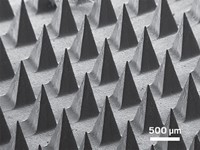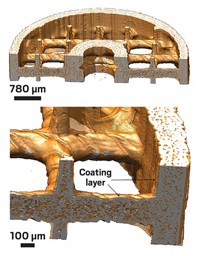Advertisement
Grab your lab coat. Let's get started
Welcome!
Welcome!
Create an account below to get 6 C&EN articles per month, receive newsletters and more - all free.
It seems this is your first time logging in online. Please enter the following information to continue.
As an ACS member you automatically get access to this site. All we need is few more details to create your reading experience.
Not you? Sign in with a different account.
Not you? Sign in with a different account.
ERROR 1
ERROR 1
ERROR 2
ERROR 2
ERROR 2
ERROR 2
ERROR 2
Password and Confirm password must match.
If you have an ACS member number, please enter it here so we can link this account to your membership. (optional)
ERROR 2
ACS values your privacy. By submitting your information, you are gaining access to C&EN and subscribing to our weekly newsletter. We use the information you provide to make your reading experience better, and we will never sell your data to third party members.
Materials
Fillable polymer microparticles offer a new means for delivering vaccines
Injected microparticles release contents at preprogrammed dosage times on the basis of polymer composition
by Celia Henry Arnaud
September 18, 2017
| A version of this story appeared in
Volume 95, Issue 37
Three-dimensional printing is a powerful technique for rapid prototyping, but when put into practical use, the approach may not be compatible with materials used for biomedical applications such as drug delivery. Robert S. Langer, Ana Jaklenec, and coworkers at Massachusetts Institute of Technology have developed an alternative method for making microdevices from biomedically relevant materials, such as poly(lactic-co-glycolic acid) (Science 2017, DOI: 10.1126/science.aaf7447). The researchers use polydimethylsiloxane molds to shape individual layers of multilayer polymeric devices. They then align, assemble, and bond the layers using heat. The MIT team used the method to make fillable polymer microparticles that release their contents according to a preprogrammed schedule on the basis of polymer composition. They built particle bases, filled them with drug solution, capped the bases with polymer lids, sealed them by heating, and then scraped the microparticles off the substrate. In a test application, the researchers made single-injection vaccines by placing antigen doses in microparticles that release the contents at desired intervals. They gave mice a single injection of a mixture of microparticles that released ovalbumin, a model antigen, nine and 41 days after injection. Those mice achieved antibody levels higher than those in mice given separate ovalbumin injections at days six and 36. In addition to drug delivery applications, the MIT researchers used the fabrication method to make a pH sensor and microfluidic devices.





Join the conversation
Contact the reporter
Submit a Letter to the Editor for publication
Engage with us on Twitter